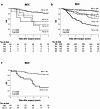Positive lymph node ratio as a nodal staging system to avoid stage migration between remnant and primary proximal gastric cancers
- PMID: 40764654
- PMCID: PMC12326014
- DOI: 10.1038/s41598-025-13766-x
Positive lymph node ratio as a nodal staging system to avoid stage migration between remnant and primary proximal gastric cancers
Abstract
Nodal staging of gastric cancer (GC) based on the number of positive lymph nodes (PLNs) is a robust prognostic factor. However, the number of retrieved lymph nodes in remnant GC (RGC) may be lower than in primary GC owing to variations in the extents of initial gastrectomy and lymphadenectomy. This study evaluated stage migration between RGC and primary proximal gastric cancer (PGC) and the clinical usefulness of the PLN ratio (PLNR) in mitigating stage migration. Among 4,142 patients who underwent gastrectomy, 91 with RGC and 768 with PGC at pStage I-III were retrospectively analyzed. A PLNR of 0.3 was the best-stratified prognosis (p < 0.001). Five-year survival in pN1-3 RGC was worse than in PGC, whereas pN0 showed no prognostic difference. PLNR stratification (0, < 0.3, and ≥ 0.3) effectively distinguished prognosis in patients with RGC (82.2, 46.6, 12.7%, respectively) and PGC (88.9, 63.4, 16.4%, respectively). High PLNR (≥ 0.3) was an independent prognostic factor in RGC (HR: 2.76, 95% CI: 1.06-7.17, p = 0.036), whereas pN stage was not. Prognostic stratification was reliable with at least five dissected lymph nodes. PLNR provides effective prognostic stratification in RGC and helps evaluate stage migration between RGC and primary PGC.
Keywords: Gastric cancer; Positive lymph-node ratio; Proximal; Remnant.
© 2025. The Author(s).
Conflict of interest statement
Declarations. Competing interests: The authors declare no competing interests.
Figures


Similar articles
-
Different prognostic effect of lymph node metastasis between remnant gastric cancers and primary proximal gastric cancers.J Gastrointest Surg. 2024 Oct;28(10):1571-1577. doi: 10.1016/j.gassur.2024.06.026. Epub 2024 Jul 2. J Gastrointest Surg. 2024. PMID: 38964532
-
Remnant gastric cancer: a neglected group with high potential for immunotherapy.J Cancer Res Clin Oncol. 2020 Dec;146(12):3373-3383. doi: 10.1007/s00432-020-03322-7. Epub 2020 Jul 15. J Cancer Res Clin Oncol. 2020. PMID: 32671505 Free PMC article.
-
The minimum number of lymph node retrieval in gastric cancer patients after neoadjuvant therapy: An international multi-institute cohort study.Surgery. 2025 Jul;183:109373. doi: 10.1016/j.surg.2025.109373. Epub 2025 May 5. Surgery. 2025. PMID: 40328160
-
Diagnostic accuracy of endoscopic ultrasonography (EUS) for the preoperative locoregional staging of primary gastric cancer.Cochrane Database Syst Rev. 2015 Feb 6;2015(2):CD009944. doi: 10.1002/14651858.CD009944.pub2. Cochrane Database Syst Rev. 2015. PMID: 25914908 Free PMC article.
-
Nodal stage migration and prognosis in anal cancer: a systematic review, meta-regression, and simulation study.Lancet Oncol. 2017 Oct;18(10):1348-1359. doi: 10.1016/S1470-2045(17)30456-4. Epub 2017 Aug 9. Lancet Oncol. 2017. PMID: 28802802
References
-
- Okajima, W. et al. Prognostic impact of the number of retrieved lymph nodes in patients with gastric cancer. J. Gastroenterol. Hepatol.31, 1566–1571 (2016). - PubMed
-
- Sinning, C., Schaefer, N., Standop, J., Hirner, A. & Wolff, M. Gastric stump carcinoma - epidemiology and current concepts in pathogenesis and treatment. Eur. J. Surg. Oncol.33, 133–139 (2007). - PubMed
MeSH terms
LinkOut - more resources
Full Text Sources
Medical
Miscellaneous

